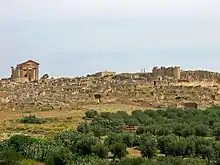Téboursouk
Téboursouk (Tunisian Arabic: تبرسق ![]() Tābūrsūq) is a town and commune in the Béja Governorate, Tunisia. It is located at 36° 27′ 26″N, 009° 14′ 54″E.
Tābūrsūq) is a town and commune in the Béja Governorate, Tunisia. It is located at 36° 27′ 26″N, 009° 14′ 54″E.
Téboursouk | |
|---|---|
Commune and town | |
 | |
 Téboursouk Téboursouk in the Béja Governorate | |
| Coordinates: 36°27′26″N 009°14′54″E | |
| Country | Tunisia |
| Governorate | Béja Governorate |
| Population (2014[1]) | |
| • Total | 22,115 |
| Time zone | UTC+1 (CET) |
Population

In 2004 it had a total population of 10,987,[2] and of 22,115 inhabitants in 2014.[1]
Geography
The town is part of the governorate of Béja, and it constitutes a municipality. Located at the foot of the Téboursouk Mountains in the Tunisian ridge, the city is built half-way up a hill at 400 m (1,300 ft) above sea level. It overlooks olive groves in the valley of Wadi Khalled.
Téboursouk is located on the territory of the Berber tribe of the Bejaoua, near the Drid tribe, at the northern end of the Haut-Tell. Located 4.6 km (2.9 mi) away are the ruins of the Roman city of Dougga.
History

During the Roman Empire, Teboursouc was known as "Tubursico-Bure", and was in the Roman province of Africa Proconsularis. The ruins of ancient Thubursicum Bure are a large Byzantine enclosure of pentagonal form, erected under the reign of Justin II (565-578), and whose northern front encompasses a Roman gate and cemetery.
The Roman city was considered a municipium.
The city obtained the statute of municipality in 1904 under the French protectorate and the status of chief town of delegation at the independence of Tunisia. In 2004, the municipality celebrated the centenary of its creation.
Bishopric
During Roman and Byzantine times the city was the seat of a Catholic diocese, the suffragan of Archdiocese of Carthage.[3][4]
There are four documented bishops of Teboursouk. Servus Dei is mentioned by Augustine of Hippo in his Contra Cresconio[5] around 404 and he had as a competitor the Donatist Bishop, Cyprian, who according to the testimony of Augustine, was deposed by Primianus (the Donatist Bishop of Carthage) because[6] "Cyprian, was caught in a brothel.
At the conference of Carthage of 411, between Catholic bishops and Donatists the same Servus Dei, and was joined by the Donatist bishop Donato, who had replaced the now disgraced Cyprian.
Bishop Reparato attended the Council of Carthage (525).
Today Tubursico-Bure survives as titular bishopric and the current titular bishop is Mykhaylo Bubniy, Exarch Archbishop of Odessa.
See also
References
- General Census of the Population and the Household 2014 by Governorates
- (in French) Recensement de 2004 (Institut national de la statistique) Archived 2016-01-22 at the Wayback Machine
- Titular Episcopal See of Thubursicum-Bure at GCatholic.org.
- J. Mesnage, L'Afrique chrétienne, Paris 1912, pp.155–156 .
- Against Cresconio, III, 43.47.
- Contra Petilian, III, 34.40
| Wikimedia Commons has media related to Téboursouk. |